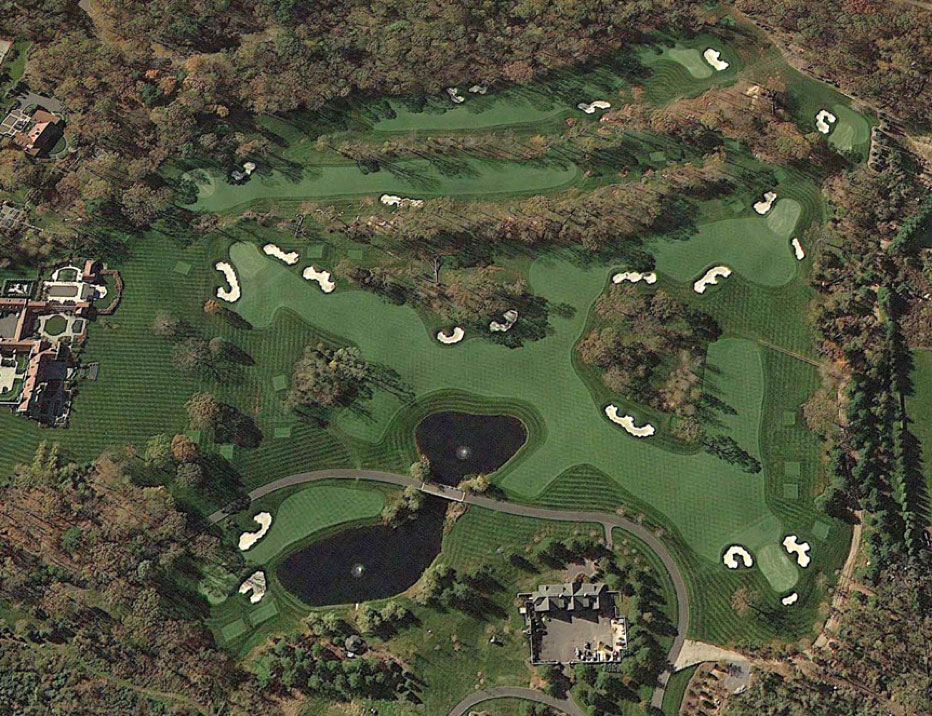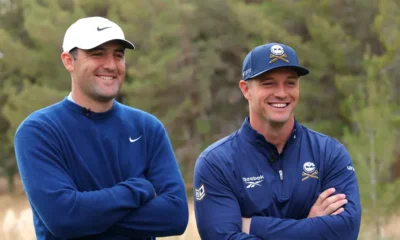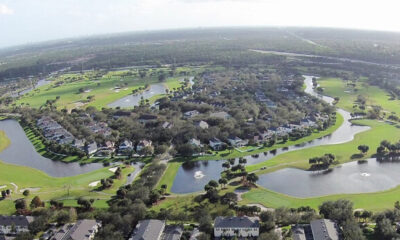Blog
The Match: 7 Things About Wynn Golf Club

Let’s get ready to rumble! Another heavyweight golf bout is on its way to Las Vegas, but this time around, the venue won’t be Shadow Creek. When brawny rivals Brooks Koepka and Bryson DeChambeau go head-to-head the day after Thanksgiving in the fifth edition of The Match, they’ll do so at Wynn Golf Club, behind the casino hotel of the same name. Like Shadow Creek, which hosted the first iteration of The Match, a $9-million extravaganza starring Tiger Woods and Phil Mickelson, the Wynn is an impeccably manicured Tom Fazio design that commands a hefty price tag. But unlike Shadow, it hasn’t been the backdrop for any recent high-profile televised events. If you’re thinking of playing the course — or just watching the event — here are seven fun facts to stuff into your trivia bank.
1. It’s a strip tease
Though it doesn’t cost as much as Shadow Creek, which recently bumped its peak-season greens fees to $1,000, the Wynn still charges plenty: $600 a round. It does so with convenience as a calling card. As the lone resort course on the Strip, it’s the only spot in town where you can roll out of your penthouse suite, ride the elevator to the ground floor and stroll directly to the first tee.
2. It was going to be a water palace
Nearly four years ago, when then-CEO Steve Wynn closed the course, blueprints were in place to transform the site into Wynn Paradise Park, a lavish aquatic playland. But Wynn wound up resigning amid sexual misconduct allegations (he no longer has any involvement with the property), and the new brass determined that a pristine golf course made more sense than what amounted to a giant swimming pool.
3. It’s a Fazio, redux
Often, when a golf course gets reworked, a new architect is called upon. In this case, though, the ownership turned to the original designer, Tom Fazio, who carried out the job with his son, Logan.
4. It has a Rat Pack past
The Strip is not St. Andrews. No one would call it hallowed ground for golf. And yet there’s history here. Long before this property became the Wynn, it was home to the Desert Inn, a resort and casino with a course of the same name. The PGA Tour, Senior Tour and LPGA Tour all competed regularly on its fairways. So did Frankie, Dino and the boys.
5. The caddies are sticks
The Wynn’s loopers aren’t just pack mules who can work a laser. The caddie corps includes former collegiate golfers, mini-tour players and assorted others whom you wouldn’t want to face in a money game. In short, you can count on savvy insights, to say nothing of some very Vegas-sounding counsel, such as: “Take this one off the Barry Manilow sign.”
6. It’s a mix of old and new
Though the rebuilt course has new greens and fairways and eight entirely new holes, it covers mostly the same footprint as its predecessor, and it preserves elements from its past, including more than 120 mature trees that date to the days of the Desert Inn. A dramatic waterfall still flows behind the 18th green, just as it did on the original Wynn course, though the hole, once a par-4, now plays as a par-3. Though Bryson and Brooks won’t be playing all 18 (theirs will be a 12-hole match, on a yet-to-be specified routing), you can bet they’ll be playing the closer. It’s just too much of a Vegas spectacle to omit.
7. Aces are wild
The odds are slim (roughly 12,500 to 1) but the payoff is fat. Anyone who makes a hole-in-one on the par-3 18th at the Wynn walks off with a cash prize of $10,000 from the resort. That rule does not apply to Brooks and Bryson, who will getting paid far more for their time in Vegas, whether they make an ace or not.
This article originally appeared on Golf.com.
Blog
Empowering the Next Generation: The Impact of Youth Golf Programs on Shaping Future Golfing Stars
As we tee off into the 21st century, golf, the age-old sport of precision and patience, is witnessing a remarkable transformation.

The Rise of Youth Programs: Unleashing the Potential of Next-Gen Golfers
As we tee off into the 21st century, golf, the age-old sport of precision and patience, is witnessing a remarkable transformation. The sport, once considered a domain of the mature and affluent, is now attracting a younger demographic like never before. The driving force behind this shift? The rise of youth golf programs.
These youth-oriented initiatives are not only making golf more accessible to younger generations but are also nurturing the next wave of golf superstars. So, grab your clubs, and let’s explore how these programs are changing the face of golf and paving the way for next-gen golfers to take center stage.

The Emergence of Youth Golf Programs
In the past, golf was often perceived as a sport for the elite, with limited opportunities for young players to learn and develop their skills. However, the landscape has dramatically changed in recent years, thanks to the emergence of youth golf programs.
These programs are designed to introduce children and teenagers to the sport, provide them with necessary training, and help them develop their skills. From local clubs offering golf lessons for kids to national organizations like The First Tee and PGA Junior League, these initiatives are making golf more accessible to younger generations.

The Impact of Youth Programs on the Golf Industry
Youth golf programs have had a profound impact on the golf industry, contributing to its growth and diversification. Here’s how:
- Increasing Participation: Youth programs have significantly boosted golf participation rates among young people. According to the National Golf Foundation, more than 2.5 million kids aged 6-17 played golf on a course in 2019, a 20% increase from 2011.
- Creating Diversity: Youth programs are also making golf more diverse. They are reaching out to children from different socio-economic backgrounds, providing them with opportunities to learn and play golf.
- Developing Talent: These programs are proving to be a breeding ground for future professionals. Young golfers like Jordan Spieth, Rickie Fowler, and Lexi Thompson, who were part of youth programs, have gone on to make their mark in the professional arena.
- Skill Development: These programs provide kids with comprehensive golf training, helping them develop technical skills like swing mechanics, putting, chipping, and bunker play. They also focus on strategic aspects like course management and decision making.
- Character Building: Golf is not just about technique; it’s also about character. Youth programs emphasize life skills such as honesty, integrity, sportsmanship, and perseverance – values that are integral to golf and life in general.
- Competitive Exposure: Youth programs also provide young golfers with competitive exposure through tournaments and leagues. This exposure helps them understand the competitive nature of the sport, learn to handle pressure, and develop a winning mentality.

How Youth Programs are Nurturing Next-Gen Golfers
Youth golf programs are making significant strides in nurturing the next generation of golfers. Here’s how:

The Bright Future of Youth Golf
The rise of youth golf programs has set the stage for a promising future. As more and more young people take up the sport, we can expect to see a new generation of golfers who are not only technically sound but also carry the values and spirit of the game.
Moreover, the increasing participation of young golfers is likely to infuse fresh energy and excitement into the sport, making it more appealing to spectators and sponsors alike.
In conclusion, the rise of youth golf programs is a game-changer. It’s not just about creating a new generation of golfers; it’s about shaping the future of golf itself. So, whether you’re a parent, a young golfer, or a golf enthusiast, it’s time to embrace these programs and support the next generation in their journey towards golfing excellence.
Blog
Unveiling the Mystique: The Enigmatic World of Secret Golf Societies
The Secret Golf Societies: Uncovering the Game’s Hidden ClubsGolf, often viewed as a gentleman’s sport, has a fascinating and sometimes mysterious allure. Beyond the lush greens and meticulously maintained courses lie secret societies, cloaked in tradition and exclusivity. These hidden clubs, often within golf’s highest echelons, have a captivating allure, creating an enigma that both…

The Secret Golf Societies: Uncovering the Game’s Hidden Clubs
Golf, often viewed as a gentleman’s sport, has a fascinating and sometimes mysterious allure. Beyond the lush greens and meticulously maintained courses lie secret societies, cloaked in tradition and exclusivity. These hidden clubs, often within golf’s highest echelons, have a captivating allure, creating an enigma that both charms and perplexes the sport’s enthusiasts. So, let’s delve into the enticing world of secret golf societies and uncover the game’s concealed clubs.

The Intrigue of Secret Golf Societies
The allure of secret societies is not a new phenomenon. The idea of a select group, privy to certain exclusive information and practices, has fascinated people for centuries. In golf, this fascination extends to secret golf societies, clubs within clubs that only welcome the select few.
These secret societies often have their own rules, traditions, and rituals, all of which contribute to their mystique. They are not your regular golf clubs; they are societies that cherish tradition, exclusivity, and most importantly, the love for the game.

Unveiling the Augusta National Golf Club
Perhaps the most famous “secret” golf society is the Augusta National Golf Club. With its Magnolia Lane entrance and green jacket tradition, the Augusta National is more than just the home of The Masters. It’s a private club steeped in tradition, where membership is by invitation only.
The club was founded by Bobby Jones and Clifford Roberts in 1932. Its exclusivity is legendary; the membership list is kept secret, and it’s reported that there are less than 300 members at any one time. The club didn’t admit its first black member until 1990 or its first female member until 2012. While its historical policies have often been controversial, the Augusta National’s allure remains undiminished.

The Ancient and Royal Golf Club
In Scotland, the birthplace of golf, lies the Ancient and Royal Golf Club of St. Andrews. This club, founded in 1754, holds the distinction of being the oldest golf society in the world. The members of this club are known to play by the original 13 rules of golf, enhancing its historical appeal.
The Outpost Club
The Outpost Club is a more modern addition to the list of secret golf societies. Founded in 2011, it’s a national golf society based in the United States. They don’t own any golf courses; instead, they organize events at various courses around the country. Membership is by invitation only, and the club’s emphasis is on camaraderie and enjoying the game in its purest form.
The Seminole Pro-Member
Often considered one of America’s most exclusive golf societies, the Seminole Pro-Member is a yearly tournament that combines amateur golfers with professional players. The tournament, held at the Seminole Golf Club in Florida, is renowned for its exclusivity. The list of past participants reads like a who’s who of golf, including legends like Jack Nicklaus and Arnold Palmer.
Why the Secrecy?
The question arises – why the secrecy? Why are these clubs so exclusive? The answer lies in the traditions of the game. Golf is a sport steeped in history and tradition. The exclusivity and secrecy of these societies preserve the traditions of the game, passing them on to future generations.
Moreover, the exclusivity also provides a unique golfing experience. The meticulously maintained courses, the camaraderie among members, and the opportunity to play the game in its purest form – these factors contribute to the allure of these secret societies.
In Conclusion
Secret golf societies, with their exclusivity and rich traditions, add a layer of intrigue to the game of golf. They preserve the sport’s history, uphold its traditions, and provide an unparalleled golfing experience. While they may be shrouded in mystery, their contribution to the game is undeniable. Whether it’s the Augusta National Golf Club, the Ancient and Royal Golf Club, or the Outpost Club, these societies embody the spirit of golf. They remind us that golf is more than just a sport. It’s a tradition, a lifestyle, and for many, a passion.
Blog
Stop Wasting Strokes: 5 Simple Drills to Kill the Dreaded 3-Putt
Tired of ruining a great hole with the dreaded 3-putt? These 5 simple drills fix your speed, conquer pressure, and turn three putts into two.

There is no feeling in golf quite as demoralizing as the 3-putt.
You smash a perfect drive. You hit a pure iron shot that lands safely on the green. You’re feeling like a pro, walking up to your ball with a birdie on your mind.
Then, disaster strikes. You blaze the first putt eight feet past the hole. Your comebacker for par is a nervous, jabby stroke that lips out. You tap in for a bogey, walking off the green with that all-too-familiar feeling of frustration, your good shots completely wasted.
The 3-putt is the great scorecard killer. It’s the difference between breaking 90 and shooting 95. The good news? It’s almost always the easiest problem to fix. It’s not about buying a $500 putter; it’s about controlling your speed and handling pressure.
Here are 5 simple, time-tested drills to kill the 3-putt and make you a confident force on the greens.
Why You 3-Putt (It’s Not What You Think)
Most amateurs 3-putt for two simple reasons, and neither has to do with a “bad stroke”:
- Poor Lag Putting: You leave your first putt so far from the hole that the second putt is still a challenge.
- Missed “Knee-Knockers”: You can’t consistently sink putts inside 3-5 feet.
These five drills are designed to fix both of those problems, starting today.
5 Drills to Become a 2-Putt Machine
Find a practice green and spend 20 minutes on these. You’ll see results in your very next round.
1. The Ladder Drill (For Lag Control)
This is the ultimate drill for dialing in your speed control.
- How to do it: Place three balls at 20, 30, and 40 feet from a hole (or use tees if you’re just practicing speed).
- The Goal: Hit the 20-foot putt, then the 30-foot, then the 40-foot. Your only goal is to get all three putts to stop within a 3-foot radius of the hole (imagine a hula-hoop around the cup).
- Why it works: It trains your brain to instinctively understand how hard to hit a putt based on distance. You’ll stop blazing putts 10 feet by or leaving them 10 feet short.
2. The Clock Drill (For Short Putt Pressure)
You must be automatic from three feet. This drill adds the pressure you feel on the course.
- How to do it: Place 12 balls in a 3-foot circle around the hole (like the numbers on a clock).
- The Goal: Go around the clock and make all 12 putts in a row. If you miss one, you must start over from the beginning.
- Why it works: It’s not just about mechanics; it’s about focus. When you get to ball #10, you will feel the pressure. This simulates the feeling of having to make a putt for par.
3. The Gate Drill (For a Pure Roll)
Missed short putts are often caused by a poor starting line. This drill gives you instant feedback.
- How to do it: Find a straight, 5-foot putt. Place two tees on the ground just wide enough for your putter head to pass through. About a foot in front of your ball, place two more tees just slightly wider than the ball itself.
- The Goal: Stroke the putter through the first “gate” and roll the ball through the second “gate.”
- Why it works: If you hit the ball off-center or have a wobbly stroke, the ball will hit the second gate. It forces you to hit the sweet spot and start the ball exactly where you’re aiming.
4. The 100-Footer (The “No 3-Putt” Zone)
This drill is simple: go to one end of the practice green and putt to a hole on the opposite end. Your goal is not to make it, but to get it inside that imaginary 3-foot circle. Do this 10 times. This makes 30 and 40-footers on the course feel like tap-ins by comparison.
5. The “Read, Roll, and React” Drill
Stop agonizing over every putt. This drill teaches you to trust your first instinct.
- How to do it: Take three balls to a 25-foot breaking putt.
- The Goal: You have 20 seconds total. In that time, you must read the green, take one practice stroke, and hit all three putts.
- Why it works: It stops “paralysis by analysis.” It trains you to pick a line, trust your speed, and accept the result. You’ll be amazed at how much better your instincts are than your over-analytical brain.
It’s About Process, Not Perfection
You’re still going to 3-putt occasionally. Even the pros do. But by practicing these drills, you’ll be building confidence and skill. You’ll stop fearing long putts and start knowing you can get them close. That confidence is the real secret to finally killing the 3-putt for good.
-

 Product Review6 years ago
Product Review6 years agoThe Perfect Practice Putting Mat Review by Jason Tenzer
-

 Blog4 years ago
Blog4 years agoLoophole Rule Offers PGA Tour Pros a Mulligan
-

 Blog4 years ago
Blog4 years ago2021 Buyer’s Guide: The Top 10 Value Golf Balls For Distance & Feel
-

 Blog4 years ago
Blog4 years agoGolf Marriage Counselor
-

 Blog6 years ago
Blog6 years ago9 Biggest Chokes Of The Past Decade
-

 Product Review6 years ago
Product Review6 years agoTHE ADJUSTABLE IRONS: WALKING STICKS GOLF CLUBS
-

 Blog4 years ago
Blog4 years agoWhat Your Golf Clubs Say About You
-

 Equipment6 years ago
Equipment6 years agoOHK Sports Interview by Jason Tenzer






























